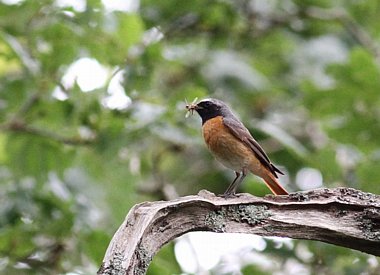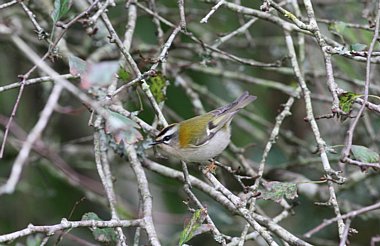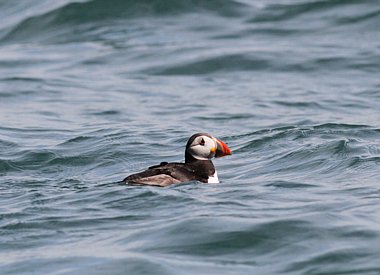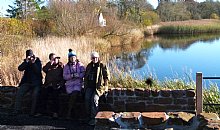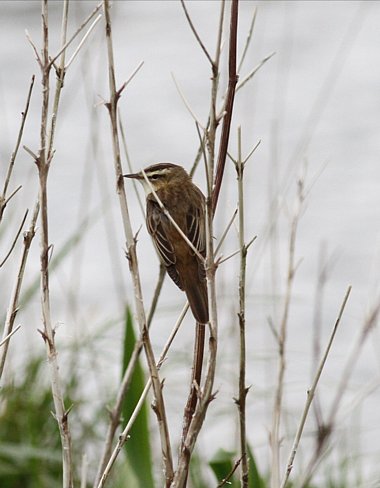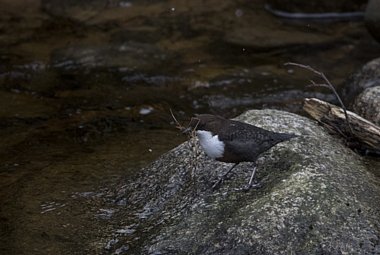South Wales in Summer
Great birding on land and sea, in a lesser known region of Wales
| Destination | |
|---|---|
| Focus | |
| Max Group Size | 7 per guide |
South Wales is a lesser-known birding holiday destination just waiting to be explored! A region with much to offer, a strong diversity of habitats, easy access and remarkably varied landscape - and of course a great many birds. We begin in the east near the Welsh Borders in Monmouthshire before relocating to Pembrokeshire in the far south west. Both centres are ideally located to enjoy their respective birds and wildlife, with much to see in between too on a planned day exploring the Gower peninsula.
In Monmouthshire we visit extensive ancient woodlands, coastal wetlands, the uplands so typical of Wales and the nearby Black Mountains, which lie on the fringes of the Brecon Beacons National Park. From our centrally located accommodation, we look for moorland species such as Red Grouse and Wheatear and explore the unique ‘fridd’, a mixed scrubby and open bracken hillside habitat where Cuckoo, Whinchat and Meadow Pipit may be found. Specialist woodland birds will be searched for, including Woodcock, Nightjar, Redstart, Wood Warbler, Pied Flycatcher and Firecrest. Along the coastal strip we visit the Severn-side RSPB reserve of Newport Wetlands, with its scarce breeding birds such as Bittern, Avocet, and Bearded Tit.
On our transfer day we visit Gower on our way to Pembrokeshire. The Gower peninsula is a quite beautiful and distinctive landscape with special local birds such as Chough and Dartford Warbler. The many nature reserves will be looking at their best, with wild flowers showing well at this time of the year.
Scenic Pembrokeshire is always an exciting place to visit, especially as it is such a long way from anywhere. Most well-known for its famous seabird colonies on the offshore islands, we plan to visit three of these - Skomer, Grassholm and Ramsey. We plan to land on Skomer and Ramsey, exploring these magical places on foot, both of which are famed for their Puffin and Manx Shearwater numbers. Our visit may coincide with the beautiful haze of blue and pink as the Bluebells and Red Campion are in flower, providing a colourful backdrop to the sheer cliffs which are often packed with thousands of Guillemot, Razorbill and Kittiwake. While not landing, by taking a boat around Grassholm the glistening white of over 39,000 pairs of Gannet will be quite the spectacle – a certain highlight among our seabird experiences! Time will also be spent exploring the mainland wildlife hotspots, visiting lakes, beautiful coastal bays and estuaries, with stops at favoured nature reserves and, if time allows, notable historic sites.
The holiday begins and ends at Newport, where rail transfers will be available. For a full Wales experience this tour can be combined with our North Wales in Summer holiday!
Day 1: Arrival and local birding
After collecting train travellers from the train station, we gather at our comfortable accommodation early afternoon. Once briefed we can head out to look for local birds and visit nearby Coed Gwent, the largest ancient woodland in Wales. Summer breeders including Pied and Spotted Flycatcher, Redstart and Wood Warbler will be high on our target list, with Dipper, Grey Wagtail, Siskin, Lesser Redpoll and a range of common warblers also likely.
Later, or on any of our three evenings based in Monmouthshire we can offer an optional evening excursion to look for Nightjar. We should hear their mechanical ‘churring’ calls and if lucky, enjoy a sighting of a bird or two feeding or displaying in the twilight, perhaps with Woodcock ‘roding’ overhead too. Roe and Fallow Deer may be encountered as they will be stirring at this time, with several bat species also possible.
Day 2: Newport Wetlands
Today we explore the Caldicot Levels, a unique area of willowy flatlands bordering the Severn Estuary at the mouth of the River Usk. Our birding will be centred around the varied habitats of Newport Wetlands with its hides, good network of flat trails and a visitor centre. This large Site of Special Scientific interest hosts many rare breeding birds and there may be some late migrating birds passing through too. Breeding waders include Avocet, Little Ringed Plover and Lapwing, while searching the extensive reedbeds may reveal Bittern (more easily heard than seen), Marsh Harrier, Bearded Tit, Cetti’s and Reed Warbler. Otter are occasionally seen here too, and later at other nearby reserves we might get lucky with Water Vole, a species just hanging on by a thread in Wales.
Day 3: The Black Mountains
Heading inland to the nearby Black Mountains, new habitats from moorland to mixed woodland offer varying, and different species to these seen on the tour so far. Among those we specifically seek are Red Grouse, Cuckoo, Whinchat and Wheatear while we may also encounter Red Kite, Hobby, Stonechat, Tree and Meadow Pipit and many others. The now very local Willow Tit is just surviving in one forestry plantations, and we will dedicate time looking for these. With the possibility of also seeing Hawfinch, Common Crossbill, Siskin and Firecrest (the latter a fairly recent colonist, but now a locally common breeding species), we will be sure of a great day.
Day 4: Grassholm and Ramsey Islands
Today we have an early start and transfer west to Pembrokeshire. An exciting two-island day awaits us , and departing from St Justinians we visit the RSPB reserve at Grassholm first. Though not landing, we take the boat close to the cliffs, experiencing the noise and throng of thousands of Gannets plus a smell you will never forget! We stand a good chance of seeing other seabirds from the boat including Manx Shearwater, auks, and perhaps dolphins and Harbour Porpoise too. Afterwards we head for Ramsey, with time to explore on foot. Many believe this lesser-known place (compared to others in the area) to actually be the most beautiful of all the Pembrokeshire islands. A location which compliments Skomer with its subtle differences and large populations of Chough, Atlantic Grey Seal and resident Red Deer.
Day 5: Gower Peninsula
Gower is a peninsula of remarkable beauty, that in character is quite separate from the rest of Wales, and notable for being designated as Britain’s first ever ‘Area of Outstanding National Beauty’. The coastal marshes, dunes and rocky shores provide unique and beautiful surroundings with a profusion of wildflowers being a particular highlight at this time. The Gower is a large area and by selecting one or two places to explore we have the chance of seeing Dartford Warbler, Chough, Raven and Peregrine before returning to our hotel in Pembrokeshire.
Day 6: Skomer Island
Just twenty minutes by boat from the Mainland, Skomer the perfect size for a day’s exploration and to enjoy its wildlife from its spectacular cliff-tops. The largest colony of Puffins in the south of Britain can be found here, and there will be a chance to get close to these comical birds. Around half of the world’s Manx Shearwater also breed on Skomer but we are only likely to see them at sea by day, the birds only visiting their nest holes under the cover darkness. Other species we may see encounter include Little and Short-eared Owl – both of which breed, plus Fulmar, Cormorant, Oystercatcher and perhaps even a late rarity such as a Rosy Starling if found by the local wardens.
Day 7: Mainland Pembrokeshire/Caernarvonshire
On our ‘spare’ day we explore the Mainland, visiting lakes, beautiful coastal bays and beaches, estuaries and favoured nature reserves. We have many options, gaps in our checklist likely dictating where we go with the Gann Estuary, Marloes Mere, Teifi Marshes or nearby Poppit Sands among the possibilities. Waders are likely to feature, the area can be good for calling Quail and coastal headlands have been known to attract a wayward Common Crossbill or Rosy Starling in June. Venturing further afield to the Llanelli Wetland Centre is another option, a site with a strong track record for 'summer' rarities including Caspian Tern, Collared Pratincole, Wood Sandpiper, Red-necked Phalarope and Spoonbill in recent years. There are many good botanical sites in the area too, while or a historical visit to St David’s Cathedral may also be possible. Though with two boat trips planned our schedule on this particular day may vary depending on the weather conditions.
Day 8: Departure
Our tour ends just after breakfast and we return east to Newport expecting to arrive around noon for drop off at the train station and other points as required.
Please note: all itineraries are given as a guide only. Actual holiday content may vary according to the judgement of your guide, and elements beyond our control (eg weather).
What's included in your holiday price
- Seven nights comfortable en-suite hotel accommodation at two well placed centres for birding activities. We choose from our personally inspected shortlist, where birders are welcome and the hospitality is special. Guests are never expected to share. Full details with your joining pack.
- Full English breakfast and dinner from Saturday evening till Saturday morning, packed lunch each day from Sunday to Friday.
- All boat trips to islands off the Pembrokeshire coast.
- All reserve entrance fees.
- All transport by comfortable minibus.
- Guidance from a professional Group Leader.
What's not included in your holiday price
- Travel to Newport rail station or other agreed meeting point.
- Insurance, drinks and other items of a personal nature
Field Notes
Weather: Expect a wide variation in weather conditions, which can be wild and unpredictable, with temperatures in Wales perhaps averaging around 16 degrees Celsius. Sunshine, rain and strong winds are all possible, and you will probably experience a bit of everything. Biting insects are not expected.
Clothing: Please bring waterproof walking boots or shoes, weatherproof clothing and a small rucksack. Boat trips and exposed coastal locations can be cold at any time of year if the wind picks up, please pack accordingly.
Walking: The holiday will be run at a relaxed pace, with time for photography, general wildlife and botany as well as fabulous birdwatching in a spectacular setting! There will be short to moderate (1 to 3 mile) walks most days mainly on well walked tracks and paths. A reasonable level of fitness would be an advantage on this tour to be able to get off the beaten track at times. Some of the islands we visit have steep steps from where the boat lands.
Other birding and wildlife holidays in Wales
Why choose Heatherlea for your birding and wildlife holiday?
Heatherlea is one of Britain's leading wildlife holiday operators. In 2019 we celebrate our 29th Anniversary with more choice than ever, both in Scotland and overseas. Relax and enjoy yourself, as we do all the planning! Above all, we make it our business to show key wildlife to you. Our fully inclusive guided holidays concentrate on the real experience, and we take time to ensure that each of our guests enjoys everything we do.
- We have been organising birding and wildlife holidays for 30 seasons, and have a highly experienced and capable office team. We also offer a telephone and email service outside normal office hours.
- We are a small company, run BY birders FOR birders. Come and see!
- Heatherlea are Mainland Scotland’s FIRST ‘5-Star Wildlife Experience!’ This is the highest available grading, classified as ‘exceptional’ by visitScotland.
- Heatherlea hold full Tour Operator Insurance for your added protection.
- Heatherlea is a limited company, registered in Scotland. We are also registered to pay VAT, which is included in your holiday price as quoted on this page.
- Once your holiday is confirmed in writing by us, we promise not to surcharge the price for any reason.



